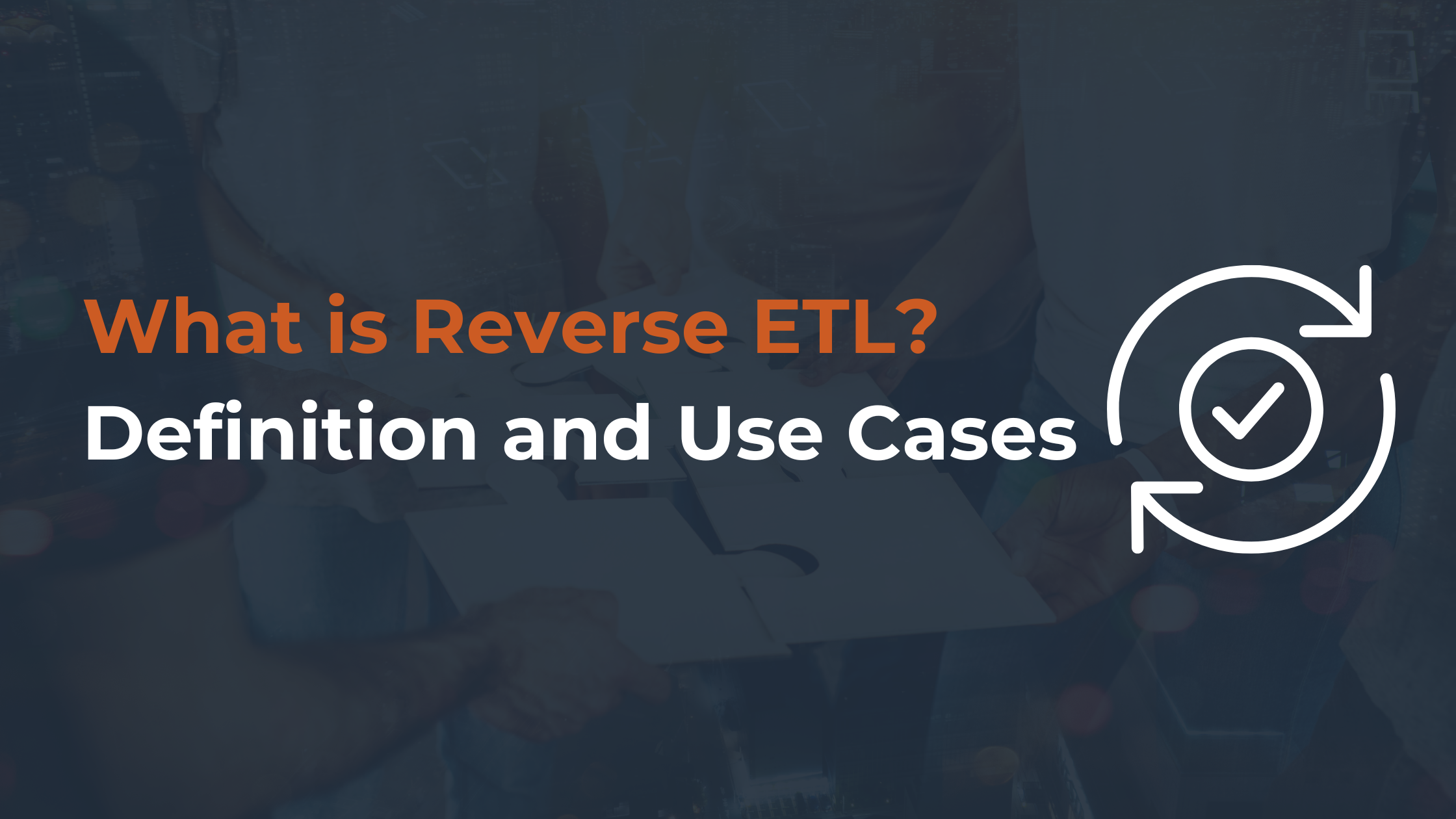Reverse ETL is the process of moving enriched, modeled data from your data warehouse into operational tools like CRMs, marketing platforms, and support systems. The blog explains how this method turns analytics into action by syncing real-time insights directly into the tools your teams use daily.
It contrasts Reverse ETL with traditional ETL and ELT workflows, outlines its key components (sources, models, syncs, and destinations), and showcases high-impact use cases, such as:
- advertising
- sales enablement
- customer marketing
- product personalization
- financial reporting
The article also explores top tools in 2025, offers guidance on choosing the right solution, and compares Reverse ETL with alternatives like iPaaS, CDPs, and point-to-point integrations.
Keep reading to get a better understanding of Reverse ETL!
Table of Content
- Reverse ETL: Meaning and How Does It Work?
- Reverse ETL vs Traditional ETL: Key Differences
- Reverse ETL Use Cases
- Choosing the Right Tool for Data Activation
- Benefits of This Data Sync Method
- Exploring Alternatives to Reverse ETL
- Final Thoughts on Reverse ETL Implementation
- Frequently Asked Questions
Reverse ETL: Meaning and How Does It Work?

Concept and Purpose Explained
What is Reverse ETL? Reverse ETL is the process of moving data from your centralized data warehouse back into operational tools like CRMs, marketing platforms, support systems, and more. Think of it as flipping the traditional ETL process on its head — instead of just collecting and storing data, you’re activating it.
The purpose? To make rich, analytical data usable across your business, where your teams already work. Sales reps get predictive lead scores directly in their CRM. Marketers can trigger campaigns based on actual product usage. Support teams can prioritize tickets using customer health scores. It’s all about turning data into action and eliminating the lag between insights and execution.
How It Fits into Modern Data Stacks
In modern data stacks, Reverse ETL sits between your data warehouse and your operational systems. Tools like Snowflake store vast amounts of raw and transformed data. But that data is only valuable if it’s accessible at the point of need.
Reverse ETL functions by running queries directly on your data warehouse and then delivering the results to your chosen operational system. These target systems can include CRMs like Salesforce or HubSpot, advertising platforms such as Google or Facebook Ads, or lifecycle marketing solutions like Braze, Iterable, or any tool where enriched data can drive action.
A typical Reverse ETL pipeline is built around four main elements: sources, models, syncs, and destinations.
- Sources refer to the location where your data currently resides —typically a centralized repository, such as a data warehouse (e.g., Snowflake) or a data lake (e.g., Databricks).
- Models define the logic for how data should be structured before it’s pushed downstream. These are typically SQL-based transformations that prepare the specific fields and tables needed for operational use.
- Syncs manage how and when your modeled data is transferred. You define which data points to send, how they should map to the destination system, and how frequently updates should occur.
- Destinations are the business tools that consume the data, most commonly CRMs, advertising networks, or marketing automation platforms, enabling teams to act on real-time insights within their everyday workflows.
Reverse ETL vs Traditional ETL: Key Differences
To fully understand the Reverse ETL meaning, it helps to revisit how traditional ETL works. In the classic ETL workflow, raw data is first extracted from systems like Salesforce, HubSpot, or Oracle. It is then transformed into an intermediary processing layer before being loaded into a target database or data warehouse.
In recent years, a more modern approach — ELT (Extract, Load, Transform) has emerged. ELT takes raw data and immediately loads it into a cloud data warehouse like Snowflake or BigQuery, where the transformation happens afterward using SQL, Python, or other processing tools. This method leverages the scalability and power of cloud computing, making it often the preferred choice for large, diverse datasets.
Both ETL and ELT move data into a centralized system. Reverse ETL, however, treats that central warehouse as the source. It extracts refined data, adapts it to match the structure and requirements of third-party platforms, and delivers it into those tools for real-time use, supporting personalization, automation, and smarter decision-making on the front lines of your business.
|
Feature |
ETL (Extract, Transform, Load) |
ELT (Extract, Load, Transform) |
Reverse ETL |
|
Data Flow Direction |
Source systems → Processing → Warehouse |
Source systems → Warehouse → In-warehouse transform |
Warehouse → Business tools |
|
Transformation Timing |
Before loading |
After loading |
Before loading into third-party systems |
|
Data Destination |
Central data warehouse or data lake |
Central data warehouse |
CRMs, support platforms, ad tools, etc. |
|
Latency |
Batch (hourly/daily) |
Often batch, can be near real-time |
Scheduled or near real-time |
|
Integration Objective |
Centralize and clean data |
Centralize and transform at scale |
Distribute clean data to action platforms |
|
Best For |
Legacy systems, compliance-heavy environments |
Modern cloud-native data stacks |
Enabling real-time insights in operational workflows |
Reverse ETL Use Cases

Reverse ETL enables companies to activate high-quality data, boosting personalization, real-time engagement, and operational intelligence at scale. Below are the most compelling Reverse ETL use cases:
Advertising
One of the most common applications for Reverse ETL is performance marketing. Marketing teams frequently request access to customer segments for campaigns, whether for building lookalike audiences, retargeting website visitors, or excluding existing customers from acquisition ads.
Reverse ETL makes this seamless by letting you build and manage audience segments directly in your warehouse and automatically sync them to platforms like Facebook Ads, Google Ads, etc. It also allows for syncing enriched event data to improve match rates, optimize spending, and ensure platform consistency. When exclusion lists are centrally maintained in your warehouse, you reduce waste and stay compliant across your ad stack, driving higher efficiency and ROAS.
Lifecycle & Customer Marketing
Delivering personalized, relevant experiences throughout the customer journey depends on having complete, up-to-date profiles. Reverse ETL helps marketers sync detailed attributes, like location, age, device, last activity, as well as behavioral flags (e.g., "added item to cart, no purchase in 7 days") or ML-based segments (e.g., “likely to churn”).
With this data flowing from your warehouse into your engagement platforms, you can build highly tailored journeys, automate touchpoints, and communicate with users based on what they do, not just static tags.
Sales Enablement
Reverse ETL gives sales teams the power of data-enriched CRM experiences. Instead of relying on what’s natively tracked in tools like Salesforce or HubSpot, you can sync product usage data, feature interaction, or expansion signals from your warehouse into the CRM.
You can also trigger real-time alerts via Slack or email when target accounts take meaningful actions, like reaching a trial usage limit, viewing key product pages, or showing signs of intent. This empowers sales reps to engage faster and more effectively, boosting conversion potential.
Product Personalization
Product teams often need to deliver personalized in-app experiences or dashboards based on aggregated user data. Reverse ETL enables teams to push metrics like usage frequency, feature adoption, or cohort data from the warehouse into production environments, allowing for tailored content, dynamic dashboards, and smarter internal tooling.
Finance Operations
Finance teams can use Reverse ETL to automate data delivery into ERP systems, billing platforms, or spreadsheets, syncing reconciled revenue numbers, invoice data, payment statuses, or order history from the warehouse.
Instead of relying on periodic manual exports or disconnected data pipelines, Reverse ETL ensures that financial systems receive timely and accurate data, streamlining reporting, audits, and operational workflows.
Data & Analytics
For data engineers and analytics teams, Reverse ETL reduces the operational burden of building and maintaining custom pipelines. These platforms read from the warehouse and push data to target tools without storing anything, keeping things simple, scalable, and secure.
Instead of creating one-off CSVs or API scripts every time marketing, sales, or support needs something, the data team just ensures the right models exist in the warehouse. Reverse ETL handles the automated, scheduled delivery, freeing teams to focus on building better models rather than managing endless integration requests.
Choosing the Right Tool for Data Activation
With a growing list of vendors offering similar functionality, selecting the right Reverse ETL platform is a strategic decision that can accelerate your data activation efforts.
Whether your goal is to enrich CRMs, personalize marketing journeys, or power internal alerts, the ideal tool will depend on your team’s workflows, your company’s architecture, and your long-term scale.
Let’s explore what’s available and what to look for.
Top Reverse ETL Tools in 2025
Here are some of the top Reverse ETL solutions, each with its unique strengths:
- Hightouch – a market leader with powerful integrations, flexible sync logic, and a user-friendly interface. Loved by data and business teams alike.
- Census – a modeling-first platform with strong dbt integration. Ideal for analytics teams focused on maintaining clean, trusted data pipelines.
- RudderStack – offers Reverse ETL as part of a broader data platform (including event tracking and CDP functionality). Great for teams looking for unified pipelines.
- Polytomic – built for business users, with a visual interface and rich filtering logic. Offers strong sync control without writing SQL.
- Grouparoo (open-source) – a flexible, developer-first platform that can be self-hosted. Great for teams who want full control over infrastructure and data flow.
Each of these tools can help activate your data, but the “best” one will depend on your team size, skillset, industry, and the complexity of your use cases.
Factors to Consider When Selecting a Tool

Before you choose a Reverse ETL tool, it’s essential to evaluate both technical compatibility and long-term business alignment. Here are the key dimensions to weigh:
1. Integration Coverage
Make sure the platform supports the exact tools you need to connect—whether that’s Salesforce, HubSpot, Facebook Ads, Intercom, or something more niche. The broader the native support, the less custom engineering you'll need.
2. Data Modeling Fit
Does your team use dbt? Raw SQL? No-code tools? Some platforms are designed for analysts and engineers, while others cater to less technical users. Choose one that fits the skillsets of those managing the syncs.
3. Security & Compliance
Reverse ETL touches sensitive data, so security is non-negotiable. Look for SOC 2 compliance, granular permissions, audit logs, and secure handling of PII or financial data. Enterprise-grade tools will offer this by default.
4. Scalability & Performance
Can the tool handle large data sets, frequent syncs, or real-time triggers? As your data volume and operational complexity grow, your platform should grow with you without increasing sync failures or costs exponentially.
5. Ease of Use & Team Access
Is the platform intuitive? Can marketing or sales ops teams manage their syncs, or will they always rely on engineers? A good UX reduces bottlenecks and empowers self-service across departments.
6. Pricing & Value
Reverse ETL tools vary widely in pricing — per sync, per record, or flat-tiered. Understand the cost model and how it scales with usage. Also consider any hidden costs: support, overages, or API rate limits.
7. Vendor Support & Documentation
When things break (and they sometimes do), you need responsive support. Look for vendors with strong documentation, a helpful community, and proven responsiveness, especially if your data activation is mission-critical.
Benefits of This Data Sync Method
By syncing enriched data from your warehouse back into your business tools, you unlock a smarter, faster, and more aligned organization. Here’s how:
✅ Real-Time Access to Enriched Data
Instead of relying on outdated exports or incomplete CRM entries, teams can act on the latest customer insights (behavioral events, segmentation, and predictive scores) all delivered directly from the data warehouse. This empowers your business to move in sync with your data.
✅ Smarter Decisions Across Teams
Whether it’s a sales rep prioritizing a warm lead or a marketer adjusting campaign timing based on user activity, Reverse ETL puts actionable data at the fingertips of decision-makers when they need it, where they need it.
✅ Reduce Data Silos and Manual Work
Manual exports, spreadsheet juggling, and fragmented logic are things of the past. With a centralized warehouse and automated syncs, everyone works from the same trusted data, reducing risk and inconsistency.
✅ Maintain Data Governance and Accuracy
Your warehouse is your single source of truth. Syncing data from it ensures consistent definitions, formatting, and security standards across all destinations, without duplication or version drift.
Exploring Alternatives to Reverse ETL
While Reverse ETL is one of the most powerful and efficient ways to activate warehouse data, it’s not the only path to integrating and syncing information across tools. Depending on your business needs and technical setup, several alternatives can offer similar functionality, each with its own advantages and limitations.
Custom-Built Integrations
Creating your own reverse data pipeline gives you full control over every aspect of the data flow. This approach is often used by companies with unique operational requirements or niche systems that off-the-shelf tools don’t support.
Custom builds are highly flexible and can be tailored to very specific use cases. However, they come with a steep price: building and maintaining these pipelines requires significant engineering effort, technical skill, and long-term upkeep. This method is powerful, but rarely efficient at scale.
iPaaS (Integration Platform as a Service)
iPaaS platforms like SyncMatters offer a more accessible alternative. With intuitive interfaces and a vast library of pre-built connectors, iPaaS tools make it easy to route data between systems with minimal coding.
They’re ideal for automating workflows quickly, especially when you need to move data across a variety of apps.
Customer Data Platforms (CDPs)
CDPs like Segment and Blueshift are designed to collect and unify customer data from multiple touchpoints, and then distribute it to marketing, sales, and support tools. These platforms shine when it comes to real-time customer profiles, segmentation, and omnichannel personalization.
However, CDPs typically focus only on customer data, not operational, financial, or product data, and may not integrate seamlessly with warehouse-first strategies. They can also be costly and require major workflow adjustments.
Point-to-Point Integrations
Pre-built, no-code connectors like those offered by Zapier, Tray.io, or native SaaS integrations make it easy to connect two applications for specific tasks. These are fast to deploy and user-friendly, making them attractive for smaller teams or simple workflows.
However, as your system architecture becomes more complex, point-to-point setups can become hard to manage and maintain. They offer limited flexibility, and may fall short for syncing modeled or enriched data between systems.
Final Thoughts on Reverse ETL Implementation

So, what is a Reverse ETL? Reverse ETL is more than just another data integration trend. By pushing clean, enriched, and modeled data from your warehouse into tools like CRMs, marketing platforms, ERPs, and support systems, you turn passive insights into real-time action.
Of course, Reverse ETL process doesn’t exist in a vacuum. It works best when paired with clear data models, defined business logic, and a culture that values operational intelligence. That’s why having a reliable partner is key.
At SyncMatters, we specialize in helping businesses integrate and activate data across dozens of CRMs, marketing systems, and cloud data platforms. Whether you’re just starting to explore Reverse ETL or scaling an enterprise-grade implementation, our team brings the tools, expertise, and support to make it seamless. From strategy to execution, we ensure your data not only flows, but flows with purpose.
Frequently Asked Questions
What Is a Reverse ETL?
Reverse ETL definition is the process of moving data from a data warehouse into operational tools like CRMs, marketing platforms, and support systems so teams can act on it in real time.
Is Reverse ETL the Same as ELT?
No. ELT loads raw data into the warehouse and transforms it there. Reverse ETL takes that transformed data out of the warehouse and syncs it to downstream tools for business use.
How Does Reverse ETL Differ from Traditional ETL?
Traditional ETL moves data into the warehouse for storage and analysis. Reverse ETL moves data out of the warehouse and into tools where teams work daily.
When Should a Business Consider Using Reverse ETL?
Businesses should consider Reverse ETL when they want to activate warehouse data in real-world operations like personalizing marketing, enriching CRM records, or triggering alerts based on user behavior.




